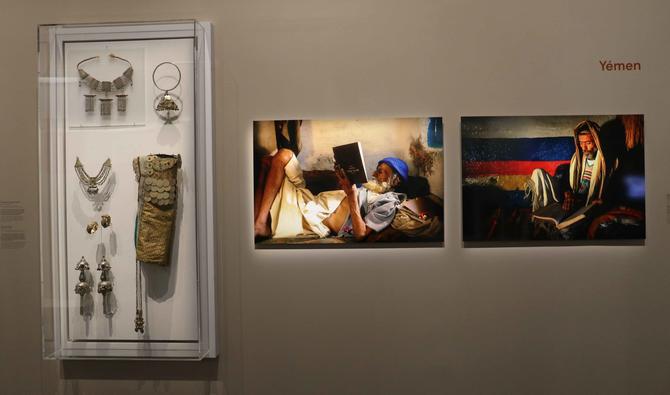PARIS: After exhibitions titled “Hajj, the pilgrimage in Makkah” in 2014 and the “Christians of the East, 2,000 years of history” in 2017, the Arab World Institute in Paris is continuing its trilogy dedicated to monotheistic religions with “Jews of the East, a multi-millennial history.”
It exhibits 280 works of art that bear witness to 15 centuries of Jewish cohabitation in the Arab world in a 1,000-square-meter space.
“This institute would only truly find its vocation if it were open to all the spiritual and intellectual heritages that have marked the history of the Arab world,” IMA President Jack Lang said in a speech to the press a few days before the exhibition’s inauguration. It is set to take place from Nov. 24 to March 13, 2022.
The Parisian institution exhibits “exceptional and unpublished” work, which were made available by 35 lenders — institutions or individuals — bearing witness to 15 centuries of Jewish cohabitation in the Arab world, from the Atlas plateaus to the banks of the Euphrates.
“Was it normal that the Jews, their culture and the Jewish religion did not have their full place here?” IMA’s president asked.
He began to handle the issue two years ago, “shortly before the appearance of these movements, that are in reality very old but reappear regularly in France, of negationism, of hatred, of racism, of denouncing the truth, of confusion.”
He continued: “This event is a response by reason, by culture, by knowledge, a response by history.”
For French President Emmanuel Macron, this is a “great lesson” about “coexistence, mutual enrichment and exchanges between monotheisms.”
He said: “Identity is always more complex than we think and rubs against other identities to feed on it,” while also denouncing the “obscurantisms” of recent times.
For the first time, Arab News en Francais has partnered up with the IMA for this exhibition. “We are very happy to work with you,” Lang rejoiced in an interview, evoking his “immense admiration for the work accomplished today in the Kingdom by Saudi authorities in general and by Prince Badr in particular.”
“People around the world have absolutely no idea how far a real cultural revolution is taking place in Saudi Arabia, in all fields such as art, cinema, theater, literature, painting, sculpture, music…,” continued the president, who will fly in a few days to Jeddah on the occasion of the Red Sea Film Festival, which promises to be a “huge event.”
He added: “I told Prince Badr, whom I met with 10 days ago: You are not broadcasting enough the magnitude of the cultural changes taking place in the Kingdom today.”
Among these Saudi sites “which one day will be more known” is the Khaybar oasis, represented by three photographs by Humberto da Silveira at the beginning of the exhibition “Jews of the East,” which retraces in a chronological and thematic journey, 15 centuries of Jewish presence in now Arab countries. The Khaybar oasis, located on a major caravan route in the Hejaz, was indeed occupied by Jewish tribes in ancient times, before the Prophet Muhammad made it the “land of Islam.”
“Today, there is a French team of archaeologists undertaking research on the spot to better understand this complex history of the Jews and the Muslims in this historic place, Khaybar, with the consent of Saudi authorities,” added the IMA president.
One of the pieces of the exhibition that most impressed Lang also comes from the Arabian Peninsula.
He admitted having great difficulty in choosing just one, given the richness of the works exhibited: “Jewish women of Yemeni origin, who have now become Israeli citizens, have created a fabulous music group that travels the world. This relationship is extraordinary, because these Jewish Yemeni women sing in Arabic.” The three Haim sisters (Tair, Liron, and Tagel) with their group A-WA, have enjoyed phenomenal success on YouTube with their song “Habib Galbi,” which mixes traditional Yemeni songs with hip-hop beats.
The public will rediscover the “Hana Mash Hu Al-Yaman” clip at the conclusion of the exhibition, the last stage in a history spanning more than 2,000 years. It shows the history of Jewish communities in the Arab world, of the first links forged between the Jewish tribes of the Kingdom and Prophet Muhammad up to the final exile, the emergence of great scholars, such as Saadia Gaon, Maimonides or Joseph Caro, during the medieval caliphates in Baghdad, Fez, Cairo and Cordoba, and the rise of Jewish urban centers in the Maghreb and the Ottoman Empire.
“Never before has the history of the Jews been told in these countries which have become Arab countries today. It had never been told on a millennial scale, from ancient times until today,” said Lang, adding: “It is a way of repairing ignorance, of showing that the Arab world is rich in successive religions and cultures, which fashioned its originality.”
Asked about the apprehensions that this exhibition could arouse on the Palestinian side, the Lang explained that “the exhibition absolutely does not address the political questions of today.”
“There are other occasions for the IMA to bring them up,” he said, referring to the upcoming publishing of a book titled “What Palestinians Bring to the World.”
Just like the general curator of the exhibition, historian Benjamin Stora, who said that “we would miss our target if we only spoke of the end, of the ‘why’ did the Jews depart,” Lang insists on showing that: “Above all, we want to show that the presence of Jews goes back a long way in history.”
This story originally appeared in French on Arab News en Francais

